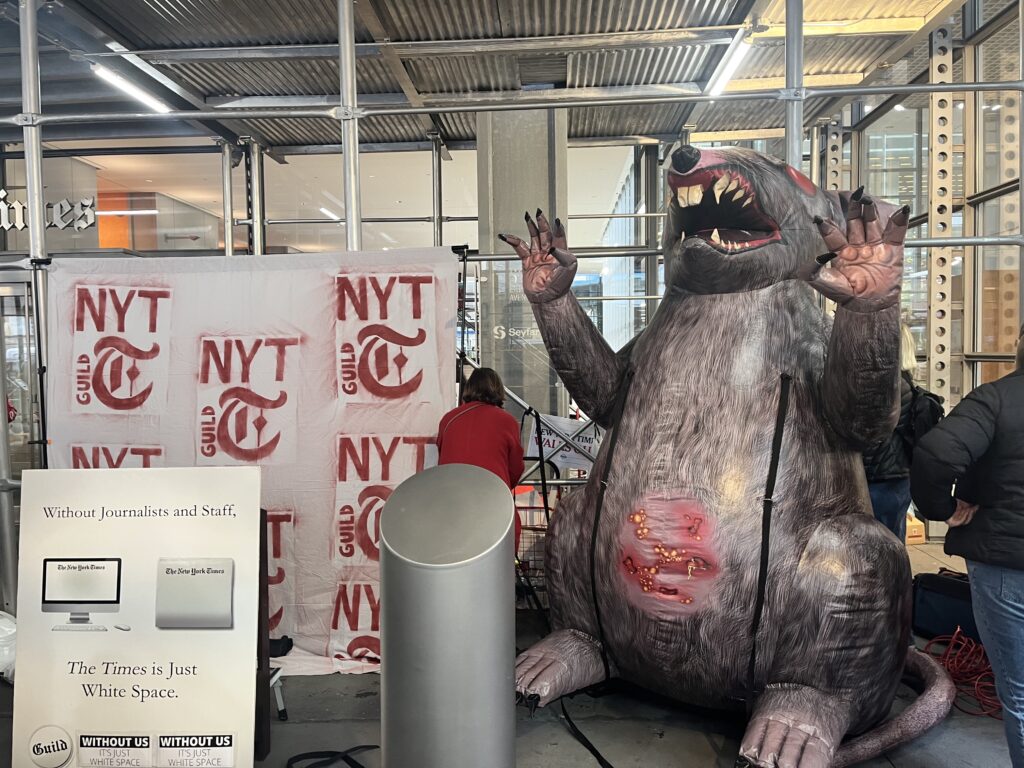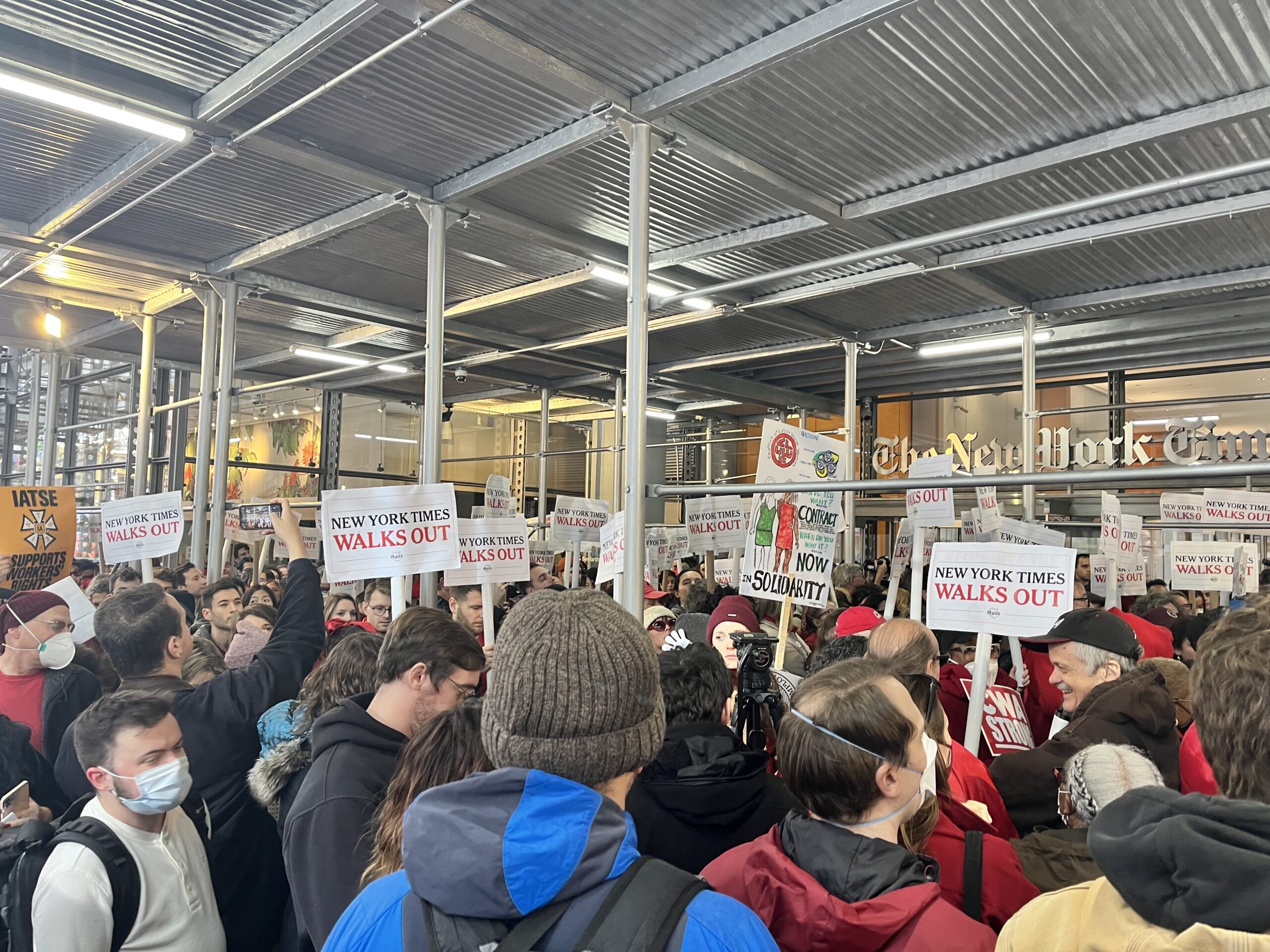Members of The New York Times Guild have been attempting to negotiate a new labor contract with company management since March 2021. The only times the guild has seen anything resembling progress is after its members have made some public noise.
“They’re like bad parents,” Tom Coffey, a New York Times senior staff editor, told the Union Progress. “They only pay attention to us when we throw tantrums.”
Last week, the guild threw its biggest tantrum yet by announcing that its members would stage a one-day walkout on Dec. 8 if a new contract wasn’t ratified before then. Like clockwork, the looming threat of a day without The New York Times led the company to make a few concessions on items it previously hadn’t been willing to budge on during a bargaining meeting earlier this week, according to Coffey, who also serves as a member of the guild’s contract action team and unit council.
This added pressure didn’t result in an immediate deal, however. As promised, about 1,100 New York Times staffers — a unit supermajority of almost 80% — walked out for 24 hours on Thursday. They held a spirited rally in the Big Apple Thursday afternoon while urging readers to not engage with any New York Times content or that of Times-owned entities such as The Athletic (or even Wordle) until midnight Friday.
“It’s really overwhelming in a great way,” said Haley Willis, a video journalist with The New York Times’ visual investigations team. “We didn’t want to get to this point. We wanted the company to avert this and give us a deal. But now we’re really here, and I’m really proud to be a part of it and be here with everyone.”
Willis has been with the Times since June 2019 and has been serving as a captain on the guild’s contract action team during the bargaining process. Like Coffey, she also observed the company being more willing to move on certain items during this week’s negotiations, which she doesn’t think is “a coincidence” given that it was their first bargaining session after revealing their intent to walk out.
The guild and company are still fairly far apart on major sticking points, such as a proposed $65,000 salary floor for every guild employee. Twenty months of negotiating without much to show for it is what led The New York Times Guild to decide it had no choice but to withhold its labor for a day to get the company’s attention.
“It just feels like so many of the proposals, the bargaining strategy has been saying no and telling us we have to accept their proposal,” Willis said. “It feels at times like we’re bargaining against ourselves.”
Similar feelings and language have been expressed many times over the past two months by Newspaper Guild of Pittsburgh members to describe their own experiences at the bargaining table.

Danielle Rhoades Ha, The New York Times’ senior vice president of external communications, said in an email to the Union Progress that the guild’s proposal “would add more than $100 million in additional costs over the life of the contract.” Regarding the walkout, she said the next bargaining session between the guild and company is Tuesday and that the company finds it “disappointing that they are taking such an extreme action when we are not at an impasse.
“Though we’ve made progress and offered several new proposals this week to address issues identified as priorities by the guild, we still have much more work to do when we return to the bargaining table,” she continued.
“We remain eager to work with the NewsGuild to reach a collective bargaining agreement that financially rewards our journalists for their contributions to the success of The Times, is fiscally responsible and continues to take into account the challenging industry landscape.”
It’s been quite a year for media labor unions exercising their rights to strike. Similar one-day walkouts occurred in 2021 across unionized Gannett newsrooms, three McClatchy-owned publications in Miami and The Morning Call in Allentown, Pa. The Fort Worth Star-Telegram has been on strike since Nov. 28 along with, of course, the Pittsburgh Post-Gazette, whose newsroom staff members walked out on Oct. 18 following the walkout of distribution, production and advertising workers on Oct. 6.
This is the first full-day New York Times strike in decades, according to Willis. It’s not lost on her or Coffey what a big deal it is to see a newspaper with the national and international clout of The New York Times essentially shut down for a day.
The New York Times Guild represents 1,400 Times workers ranging from high-profile journalists to equally valuable employees such as security staff, news assistants and content moderators. Star reporters and guild members Jodi Kantor and Megan Twohey were recently featured in “She Said,” a film based on the 2019 book they wrote about their investigation into Harvey Weinstein’s history of sexual abuse and misconduct.
So, what was The New York Times Guild hoping to accomplish with Thursday’s action? For Willis, it was giving management a taste of what it would be like if 1,100 Times staff members embarked on a large-scale strike.
“It will hit the company where it hurts,” Willis said. “We want them to realize we have the backing of the readership and all our colleagues in the union. If they want the paper to be successful, they’ll have to pay us for that labor.”
Coffey has been with The New York Times since 1997. He was around in 2012 when the guild agreed to help the then financially flailing New York Times by accepting a contract with reduced wage increases and a less advantageous pension plan. The issue of salary was put on the back burner during 2017 contract bargaining in favor of ironing out a health care plan that ultimately raised both deductibles and copays for guild members, Coffey said.
These days, The New York Times is doing much better from an economic perspective, as both Coffey and Willis pointed out is evidenced by current executive salaries, the amount the company has spent on stock buybacks and its recent acquisitions of The Athletic and Wordle.
“They have money, and they’re willing to spend it on anything but the rank and file,” Coffey said.
The Post-Gazette was represented in the Big Apple Thursday by striking Newspaper Guild of Pittsburgh members Natalie Duleba and Erin Hebert. They were cheered on by some of The New York Times Guild members leading the charge in front of a crowd of hundreds.
“It was so energizing to be there today and especially to hear the cheers when the NYT Guild’s unit chair gave us a shoutout during his speech,” Hebert said. “The workers at the Times know their worth and are fighting for the exact same things we are — dignity, respect and a fair contract.”
Added Duleba: “The energy outside The New York Times building was electric and encouraging. The NewsGuild is strong and clearly knows what its members are worth. There are so many parallels between our fight against the Blocks and their fight against the Times, which really spotlights how important it is to fight back and stand in solidarity.”
There were quite a few prominent New York Times employees expressing their support for the walkout during Thursday’s rally. Sports reporter Jenny Vrentas praised her “large and incredibly united union” for its solidarity and hard work.
“We and journalists everywhere know we do our best work when we’re treated fairly and equitably,” she said. “For journalists fighting similar fights in newsrooms across the country and world, we see you, and we’re doing this for you, too.”
Nikole Hannah-Jones, a domestic correspondent for The New York Times Magazine, said that she’s “deeply disappointed by our company’s negotiation team” and “equally awe-struck and inspired by the tireless efforts of our bargaining committee.” She emphasized the guild’s request to establish a diversity committee that has so far fallen on deaf ears.
“What we are asking is that every member of our guild be treated fairly, judged on their merits and paid what they’re worth,” Hannah-Jones said.
Willis appreciates all her co-workers who were willing to participate in the walkout, which she characterized as “something scary for the benefit of all of us.” She had a message for New York Times management as contract negotiations continue.
“Pay us what we’re worth,” she said. “We hear a lot of platitudes. … Seeing a contract that values us is the only thing that’s going to move toward restoring faith in the company and the company’s mission.”
Joshua covers pop culture, media and more at the Pittsburgh Post-Gazette, but he's currently on strike. Contact him at jaxelrod@unionprogress.com.



